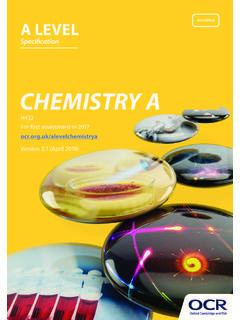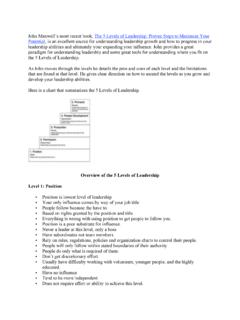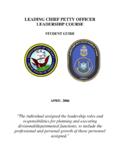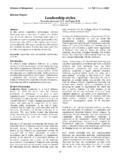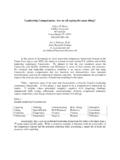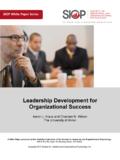Transcription of Cambridge TECHNICALS LEVEL 3 SPORT AND …
1 2 sports coaching and activity le adership M/507/4453 Guided learning hours: 90 Version 4 - revised March 2017*ch anges indicated by black lineCambridge TECHNICALS LEVEL 32016 SuiteSPORT AND PHYSICAL ACTIVITYF irst teaching September 2016 LEVEL 3 UNIT 2: sports coaching and activity leadership M/507/4453 Guided learning hours: 90 Essential resources required for this unit: For LO4, LO5 and LO6, learners will need access to participants for a sports or activity session. Learners will also need access to appropriate facilities and equipment suitable to the SPORT or activity and the participants they are working with. This unit is internally assessed and externally moderated by OCR. UNIT AIM At some point throughout their lives everyone will have experienced being coached or taught about SPORT and physical activity. The importance of a high quality coach or leader cannot be underestimated. The increasing demand for both young and old to learn and develop physical skills and sporting skills presents new and exciting opportunities for coaches, leaders and NGB s and, through coaching and leading, you can learn a set of skills such as communication and adaptability which will prove valuable in other aspects of your life, such as work and study.
2 This unit will give you an understanding behind the theory of what makes good sports coaches and activity leaders and methods that can be employed to improve the performance of participants. You will explore the roles and responsibilities of coaches and leaders and how these differ from each other and others involved in delivering and teaching SPORT and physical activity. The main part of the unit is related to you developing the skills and understanding necessary to effectively plan and deliver a series of sports or activity sessions reflecting on your own practice and using this feedback to improve your performance as a sports coach or activity leader. OCR 2017 1 Unit 2: sports coaching and activity leadership First teaching September 2016 TEACHING CONTENT The teaching content in every unit states what has to be taught to ensure that learners are able to access the highest grades. Anything which follows an details what must be taught as part of that area of content.
3 Anything which follows an is illustrative; it should be noted that where is used, learners must know and be able to apply relevant examples in their work, although these do not need to be the same ones specified in the unit content. For internally assessed units you need to ensure that any assignments you create, or any modifications you make to an assignment, do not expect the learner to do more than they have been taught, but must enable them to access the full range of grades as described in the grading criteria. Learning outcomes Teaching content The Learner will: Learners must be taught: 1. Know the roles and responsibilities of sports coaches and activity leaders Roles of sports coaches and activity leaders ( role model, motivator, planner, instructor, mentor, facilitator, demonstrator, adviser, supporter, fact finder, counsellor, organiser) Responsibilities of sports coaches and activity leaders ( sets agreed ground rules, fair, consistent, ethical, duty of care, safeguard, assess risk, promote health and wellbeing, codes of conduct, importance of being a role model, rules and regulations of the SPORT or activity) How the roles and responsibilities involved in teaching and delivering SPORT differ, sports coach ( focus more on performance and reaching the peak, are usually focused on one SPORT , may work with a broad range of abilities from beginners to elite performers, may use a range of analysis techniques to enhance performance)
4 sports /activity leader ( concerned with SPORT for all , about taking part and being active rather than skill development, often across a range of activities, may not be sports based) PE Teacher ( focus on health and wellbeing, have to teach more than one SPORT , have a broader social responsibility, within the constraints of the curriculum and school/college policies) differences between coaches, coaching assistants and officials OCR 2017 2 Unit 2: sports coaching and activity leadership First teaching September 2016 Learning outcomes Teaching content The Learner will: Learners must be taught: 2. Understand principles which underpin coaching and leading Principles of leadership ( styles ( autocratic, democratic, laissez-faire), personality ( aggressive, passive, introvert, extrovert, NACH, NAF, type a, type b), suitability of different leadership approaches in different situations) Group dynamics ( stages of group development, cohesion ( group cohesion, size, social loafing, stability), creating an effective team environment (communicate, knows their role, keep changes to a minimum, encourage a group identity, rewarding positive behaviour and dealing with discriminatory behaviour), Steiner s model of group effectiveness Attributes of coaches and leaders, communication skills able to establish and maintain relationships knowledge of the activity organisational skills empathy 3.)
5 Be able to use methods to improve skills, techniques and tactics in SPORT Methods for identifying strengths and weaknesses in skills, techniques and deployment of tactics, self-assessment ( in comparison to team mates, review of recent results, role model comparison) peer assessment ( feedback from coach) Classification of skills and its links to types of practice, open/closed ( performed in adaptable or stable environment ( pass in football is open, badminton serve is closed)) gross/fine ( requires large or intricate muscle movement ( shot putt is gross, shot in snooker is fine)) simple/complex ( transferable among sports or unique to one ( running is a simple skill, a golf swing is complex)) discrete/serial/continuous ( discrete is a single movement (flicking a hockey ball up), serial is a series of discrete skills (triple jump), continuous has no discernible start or end point (cycling)) types of practice, o whole o part o whole-part-whole o variable o fixed o massed o open Methods for measuring improvement in skills, techniques and deployment of tactics ( self-assessment by participants, peer assessment, coach assessment, observation, objective measures ( goals scored, distance jumped), performance analysis technology ( slow-motion replay)) OCR 2017 3 Unit 2: sports coaching and activity leadership First teaching September 2016 Learning outcomes Teaching content The Learner will: Learners must be taught: 4.
6 Be able to plan sports and activity sessions Review participants needs considering which could influence coaching sessions, age, including the differences between adults and children gender LEVEL of ability and stage of participant development experience fitness levels health issues/medical conditions/disability ( asthma, sight impairment) what they want out of it ( to develop specific skills or roles) shared protected characteristics Key considerations when planning sports /activity sessions, goals for each session, ensuring that they meet the needs of individual participants and the group SPORT /activity session plans follow accepted good practice for the SPORT or activity and are consistent with own LEVEL of technical knowledge and competence sports /activities and styles will motivate the participants and achieve planned goals, for each session in the series realistic timings, sequences, intensity and duration of activity plans allow for a balance of instruction, activity and discussion resources required for each session plan for differentiation ( know how activities can be adapted to both increase and decrease the LEVEL of challenge) mental capabilities and key methods for improving participants performance (connection, confidence, concentration, motivation, emotional control, cohesion)
7 SMART goal setting, Specific Measurable Achievable Recorded Time-phased 5. Be able to prepare sports and activity environments Preparing equipment for sports /activity sessions, amount and type of equipment is sufficient for the needs of the planned session size and type of equipment is suitable for the needs of all participants and using adapted equipment where necessary adapt the planned use of equipment as and when necessary ( if the amount, type, working order or other aspect of the available equipment make the planned activities untenable) reasonable steps to ensure that all equipment is in optimum working order ( pumping up balls, restringing rackets, referring broken or damaged equipment to the appropriate person) OCR 2017 4 Unit 2: sports coaching and activity leadership First teaching September 2016 Learning outcomes Teaching content The Learner will: Learners must be taught: Preparing the environment for sports /activity sessions, appropriate space for the number of participants rearrange elements of the working space to ensure safety ( move benches out of the way, tidy stray balls, wrap nets neatly) appropriate markers to ensure participants are aware of the space they have available ( mark out the space using cones, lines or other markers) reasonable steps the ensure the safety of the working area ( mop-up spills, cone-off unsafe areas, report hazards to an appropriate person)
8 Assessing and minimising risks before sports /activity sessions, identify and adapt as necessary existing risk assessments for, o the activities o the equipment o the environment o the participants identify possible hazards assess the risk that identified hazards present, including likelihood of occurrence and severity assess how to minimise the identified risks identify an appropriate person who can advise if there are hazards or risks outside of own LEVEL of competence comply with information in the normal operating procedures for where the session will take place Appropriate safeguarding policies and procedures ( the relevant procedures for safeguarding children and vulnerable adults, the relevant procedures for protecting self from accusations, report possible signs of abuse, procedures for recording and reporting concerns about the welfare of children and vulnerable adults) 6. Be able to deliver sports and activity sessions Preparing participants for SPORT /activity sessions, meet the participants punctually ensure participants are made to feel welcome and at ease, record attendance ensure participants physical readiness for the session ( check for injuries and illness, treatment for known conditions is available such as an inhaler) ensure participants have the correct clothing and equipment establish behaviour rules for the session awareness of goals of session Delivering warm-up activities which are appropriate for the participants and session, pulse raising mobility dynamic movements stretching skill rehearsal OCR 2017 5 Unit 2: sports coaching and activity leadership First teaching September 2016 Learning outcomes Teaching content The Learner will: Learners must be taught.
9 Delivering SPORT /activity sessions, activities that are clearly in line with the session goals provide technically correct explanations and demonstrations appropriate to participants needs and LEVEL of experience motivate participants appropriate to their needs and in line with accepted good practice communicate effectively and clearly with all participants ensure all participants have the opportunity to take a full and active part in planned activities ensure all participants achieve and enjoy the session deliver sessions at a pace appropriate to the participants needs carry out emergency procedures when appropriate review participants performance considering strengths, weaknesses, areas for improvement use appropriate coaching styles and methods provide feedback to participants during the session to help participants achieve their goals adapt sessions to respond to the participants changing needs provide opportunities for participants to reflect on their learning and apply their reflections to their performance encourage participants to take responsibility for their own learning Concluding coaching sessions, ensure there is sufficient time to conclude the session deliver cool down activities appropriate to the participants and session, o pulse-lowering o stretching encourage participants to give feedback provide feedback to participants on their performance relating to their/the goals provide information to participants about future sessions ensure participants complete the session safely follow procedures for checking and dealing with equipment used.
10 Leaving the coaching environment in a condition fit for future use 7. Be able to review sports and activity sessions Reviewing SPORT /activity sessions, evaluate the participants progression according to the session evaluation plan and against planned goals review the effectiveness of the activities, and session overall against planned goals evaluate the effectiveness of own management of the session, including health and safety and welfare issues consider participants feedback in evaluating their performance provide feedback to participants ( verbal/written in next session) record evaluations for future reference OCR 2017 6 Unit 2: sports coaching and activity leadership First teaching September 2016 GRADING CRITERIA LO Pass Merit Distinction The assessment criteria are the Pass requirements for this unit. To achieve a Merit the evidence must show that, in addition to the Pass criteria, the candidate is able to: To achieve a Distinction the evidence must show that, in addition to the pass and merit criteria, the candidate is able to: 1.
